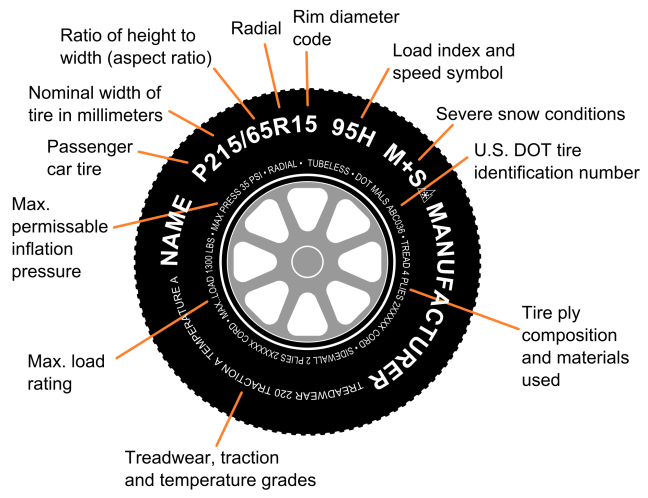Today we’ll be answering your questions about tires, the stylish black shoes your car wears. They do all sorts of great things, like insulating our cars against lightning strikes and, you know, giving them lateral grip and traction and all that good stuff.
Ok the function is pretty basic, but there’s always more to know. For instance…What do the numbers and letters on the sidewall of my tires mean?
The markings on the side of your tires are more than just a serial code. Broken down into sections, each one provides an important measurement or rating that is key to equipping your vehicle with the right rubber. This calls for a diagram.

Voila. Now, let’s go in order.P – The first letter designates what kind of vehicle the tires are meant for. P is for Passenger vehicles. LT, another option, is for Light Trucks. C is for Commercial. This letter is often omitted from newer tires.215 – The first number is the tire’s width in millimeters. Simple.65 – Separated by a slash, the second number is the tire’s aspect ratio, sometimes referred to as its profile. Expressed as a percentage, this is a measurement of the height of the sidewall relative to the overall width of the tire. In this case, 65% of 215 millimeters. A smaller aspect ratio, or a lower profile, means you’ve got thinner tires suited for performance settings, whereas a larger aspect ratio, or a higher profile, will give you big, beefy sidewalls that will take care of you off-road.R – Stands for Radial, the method by which this tire and most others are constructed. In fact, radial tires are so ubiquitous that this letter is treated as just another separator between the aspect ratio and the diameter.15 – In inches, the diameter of the rim this tire fits on. Corresponds to the listed wheel size of your vehicle.95H – This is the service description. The number represents the tire’s load rating, while the letter matches to a speed rating. Our sample tire is rated for 1390 lbs and 130 mph. Note that load ratings are listed on a per tire basis. The speed rating isn’t really that important because the lowest rating (N) is 87 mph, which is above any posted speed limit in the US. You’ve never exceeded 87 mph, have you?M+S – If you’re rocking all-season tires, they’re stamped with these letters as a show of their Mud and Snow readiness. Summer tires lack this mark, and winter tires will show M+S as well as a symbol that looks like a snowflake over a mountain.TREADWEAR 220 – Treadwear is a rating of how long a tire will last. The bigger the number, the farther you’ll go. The ratings range from 100 to 700, and this 220 tire is supposed to last a little more than twice as long as a tire with a treadwear of 100. Summer tires generally have lower treadwear ratings than all-season tires.TRACTION A – This scale uses rankings of AA, A, B, and C to grade a tire’s traction during straight-line acceleration and braking. Cornering grip doesn’t factor in. AA is the best grade.TEMPERATURE A – The more friction generated by a tire, the more heat builds up. A tire’s temperature rating tells you how much heat it can withstand. We grade tires on a scale that correlates to speed, with C able to dissipate heat from 85-100 mph, B for speeds of 100-115 mph, and A for speeds above 115 mph. Again, unless you’re doing frequent burnouts in your car and going well over the posted speed limit, this shouldn’t be important for you.
There are a number of finer measurements and notations along the inner edge of the tire, including the maximum PSI a tire can withstand (not the same as the recommended PSI located on the driver’s doorjamb), a DOT label that will tell you where and when your tire was manufactured, and details of the tire’s construction materials


